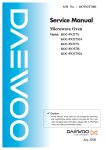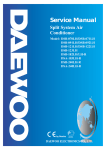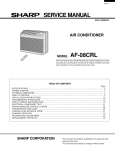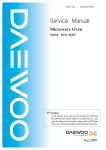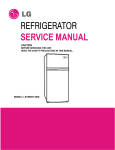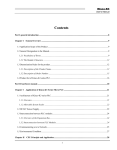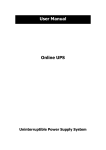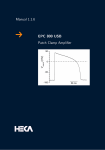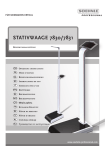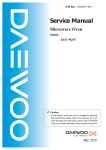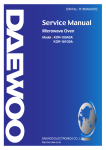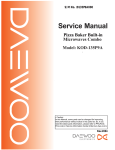Download Service Manual
Transcript
S/M No. : OC9U0T7S01
Service Manual
Microwave Oven
Model: KOC-9U0T7S
?
Caution
: In this Manual, some parts can be changed for improving,
their performance without notice in the parts list. So, if you
need the latest parts information, please refer to PPL(Parts
Price List) in Service Information Center (http://svc.dwe.co.kr).
Mar. 2008
PRECAUTIONS TO BE OBSERVED BEFORE AND
DURING SERVICING TO AVOID POSSIBLE
EXPOSURE TO EXCESSIVE MICROWAVE ENERGY
(a) Do not operate or allow the oven to be operated with the door open.
(b) Make the following safety checks on all ovens to be serviced before activating the magnetron or other
microwave source, and make repairs if necessary: (1) Interlock operation, (2) Proper door closing, (3)
Seal and sealing surfaces (arcing, wear, and other damage), (4) Damage to or loosening of hinges and
latches (5) Evidence of dropping or abuse.
(c) Before turning on power to the microwave oven for any service test or inspection within the microwave
generating compartments, check the magnetron, wave guide or transmission line, and cavity for proper
alignment, integrity, and connections.
(d) Any defective or misadjusted components in the interlock, monitor, door seal and microwave
generation and transmission systems shall be repaired, replaced, or adjusted by procedures described
in this manual before the oven is released to the owner.
TABLE OF CONTENTS
1. SAFETY AND PRECAUTIONS....................................................................................................................................2
2. SPECIFICATIONS ........................................................................................................................................................3
3. EXTERNAL VIEW.........................................................................................................................................................4
3-1. OUTER DIMENSION ..........................................................................................................................................4
3-2. FEATURE DIAGRAM .........................................................................................................................................5
4. INSTALLATION ............................................................................................................................................................6
5. CONTROL PANEL .......................................................................................................................................................7
6. DISASSEMBLY AND ASSEMBLY ..............................................................................................................................8
7. INTERLOCK MECHANISM AND ADJUSTMENT.....................................................................................................17
8. TROUBLE SHOOTING GUIDE ..................................................................................................................................18
9. MESUREMENT AND TEST .......................................................................................................................................23
9-1. MEASUREMENT OF THE MICROWAVE POWER OUTPUT ........................................................................23
9-2. MICROWAVE RADIATION TEST ....................................................................................................................24
9-3. COMPONENT TEST PROCEDURE................................................................................................................25
9-4. COMPONENT ACTION....................................................................................................................................26
10. WIRING DIAGRAM...................................................................................................................................................27
11. EXPLODED VIEW AND PARTS LIST .....................................................................................................................28
11-1. DOOR ASSEMBLY.........................................................................................................................................28
11-2. CONTROL PANEL ASSEMBLY.....................................................................................................................28
11-3. TOTAL ASSEMBLY........................................................................................................................................28
12. PRINTED CIRCUIT BOARD ....................................................................................................................................31
13. P.C.B CIRCUIT DIAGRAM.......................................................................................................................................36
1
1. SAFETY AND PRECAUTIONS
1. FOR SAFE OPERATION
Damage that allows the microwave energy (that cooks or heats the food) to escape will result in poor cooking and may
cause serious bodily injury to the operator.
IF ANY OF THE FOLLOWING CONDITIONS EXIST, OPERATOR MUST NOT USE THE APPLIANCE.
(Only a trained service personnel should make repairs.)
(1) A broken door hinge.
(2) A broken door viewing screen.
(3) A broken front panel, oven cavity.
(4) A loosened door lock.
(5) A broken door lock.
The door gasket plate and oven cavity surface should be kept clean.
No grease, soil or spatter should be allowed to build up on these surfaces or inside the oven.
DO NOT ATTEMPT TO OPERATE THIS APPLIANCE WITH THE DOOR OPEN.
The microwave oven has concealed switches to make sure the power is turned off when the door is opened.
Do not attempt to defeat them.
DO NOT ATTEMPT TO SERVICE THIS APPLIANCE UNTIL YOU HAVE READ THIS SERVICE MANUAL.
2. FOR SAFE SERVICE PROCEDURES.
1. If the oven is operative prior to servicing, a microwave emission check should be performed prior to servicing the
oven.
2. If any certified oven unit is found to servicing, a microwave emission check should be performed prior to servicing the
oven.
(1) inform the manufacturer, importer or assembler,
(2) repair the unit at no cost to the owner,
(3) attempt to ascertain the cause of the excessive leakage,
(4) tell the owner of the unit not to use the unit until the oven has been brought into compliance.
3. If the oven operates with the door open, the service person should tell the user not to operate the oven and contact
the manufacturer immediately.
IMPORTANT
The wire in this mains lead coloured in accordance with the following code.
Green-and-yellow : Earth
Blue
: Neutral
Brown
: Live
As the colours of the wires in the mains lead of this appliance may not correspond with the coloured markings
identifying the terminals in your plug, proceed as follows:
The wire which is coloured green-and-yellow must be connected to the terminal in the plug which is marked with the
letter E , earth symbol or coloured green-and-yellow.
The wire which is coloured blue must be connected to the terminal which is marked with the letter N or coloured
black.
The wire which is coloured brown must be connected to the terminal which is marked with the letter L or coloured
red.
NOTE : This oven is designed for counter-top use only.
2
2. SPECIFICATIONS
MODEL
KOC-9U0T7S
POWER SUPPLY
230V~50Hz, SINGLE PHASE WITH EARTHING
MICROWAVE
1500W
POWER
GRILL
1950W
CONSUMPTION
CONVECTION
1950W
COMBINATION
1950W
MICROWAVE ENERGY OUTPUT
900W (IEC 705)
MICROWAVE FREQUENCY
2450MHz
OUTSIDE DIMENSIONS (W X D X H)
542X438X329mm(21.5X17.2X13 in.)
CAVITY DIMENSIONS (W X D X H)
350X367X240mm(13.8X14.4X9.4 in.)
NET WEIGHT
Approx. 18.2Kg (40.1 lbs.)
TIMER
60 minutes
FUNCTION SELECTIONS
Microwave / Grill / Convection / Combination
POWER SELECTIONS
10 LEVELS
CAVITY VOLUME
1.1 Cu. Ft
* SPECIFICATION ARE SUBJECT TO CHANGE WITHOUT NOTICE.
3
3. EXTERNAL VIEW
1. OUTER DIMENSION
4
2. FEATURE DIAGRAM
13
2
4
11
12
6
7
1
8
9
5
10
3
11. DOOR HOOK
When the door is closed, it will automatically lock shut. If door is opened while oven is operating, the magnetron
will immediately stop operating.
12.DOOR VIEWING SCREEN
Allows viewing of food. The screen is designed so that light can pass through, but not the microwave.
13. METAL RACK
14. TOP HEATER
Turns on when convection, grill and combi cooking is selected.
15. BOTTON HEATER
Turns on when convection, grill and combi cooking is selected.
16. OVEN LAMP
Automatically turns on during oven operating.
17. SAFETY INTERLOCK SYSTEM
18. CONTROL PANEL
19. Metal Tray
Put food or appropriate cookware directly on the metal tray and place on the glass turntable and then place on the
roller guide when using convection cooking, combination cooking, auto cooking or grill cooking.
10. COUPLER
This fits over the shaft in the center of the ovens cavity floor. This is to remain in the oven for all cooking.
11. CONVECTION OUTLET & FAN
12. OVEN FRONT PLATE
13. DOOR SEAL
Door seal maintains the microwave energy within the oven cavity and prevents microwave leakage.
5
4. INSTALLATION
1. Steady, flat location
This microwave oven should be set on a steady, flat surface.
This microwave oven is designed for counter top use only.
2. Leave space behind and side
All air vents should be kept a clearance. If all vents are covered during operation, the oven may overheat and, eventually,
cause failure.
3. Away from Radio and TV sets
Poor television reception and radio interference may result if the oven is located close to a TV, Radio, antenna or feeder
and so on.
Position the oven as far from them as possible.
4. Away from heating appliances and water taps
Keep the oven away from hot air, steam or splash when choosing a place to position it, or the insulation might be
adversely affected and breakdowns occur.
5. Power supply
Check your local power source. This microwave oven requires a current of approximately 8.5 amperes, 230V, 50Hz.
Power supply cord is about 1.0 meters long.
The voltage used must be the same as specified on this oven. Using a higher voltage may result in a fire or other
accident causing oven damage. Using low voltage will cause slow cooking. We are not responsible for damage
resulting from use of this oven with a voltage of ampere fuse other than those specified.
This appliance is supplied with cable of special type, which, if damaged, must be repaired with cable of same type.
Such a cable can be purchased from DAEWOO and must be installed by a Qualified Person.
6. Examine the oven after unpacking for any damage such as:
A misaligned door, broken door or a dent in cavity.
If any of the above are visible, DO NOT INSTALL, and notify dealer immediately.
7. Do not operate the oven if it is colder than room temperature.
EARTHING INSTRUCTIONS
This appliance must be earthed. In the event of an electrical short circuit, earthing reduces the risk of the electric shock by
providing an escape wire for the electric current. This appliance is equipped with a cord having a earthing wire with a
earthing plug. The plug must be plugged into an outlet that is properly installed and earthed.
WARNING
Improper use of the earthing plug can result in a risk of electric shock.
Consult a qualified electrician of serviceman if the earthing instructions are not completely understood, or if doubt
exists as to whether the appliance is properly earthed, and either:
If it is necessary to use an extension cord, use only a 3-wire extension cord that has a 3-blade earthing plug, and a
3-slot receptacle that will accept the plug on the appliance.
The marked rating of the extension cord should be equal to or greater than the electrical rating of the appliance, or
Do not use an extension cord.
6
5. CONTROL PANEL
1
7
1 Display : Cooking time, power level, program
indicators and present time are displayed.
MW ( ): When blinking, the oven is
operating in MICROWAVE COOK
mode.
Grill ( ): When blinking, the oven is
operating in GRILL mode.
Combi ( ): When blinking, the oven is
operating in COMBI mode.
Defrost ( ): When blinking, the oven is
operating in DEFROST mode.
Auto-cook ( ): When blinking, the oven is
operating in AUTO COOK
mode.
Convection ( ): When blinking, the oven is
operating in CONVECTION
mode.
gram ( ): When blinking, the oven is
operating in weight input mode.
2 Combi : Used to select combi mode.
3
e
5
4
6
w
2
8
3 Defrost : Used to defrost foods.
4 MW : Used to set power level of the
microwave.
5 Clock : Used to set clock.
6 Grill : Used to select grill mode.
7 Auto cook : Used to cook or reheat.
q
0
9
8 Convection : Used to select convection
mode and selected temp.
9 Dial knob : Used to set time, weight and
quantity.
0 START/SPEEDY COOK : Used to start a
program or a speedy start(each press adds
30 seconds of microwave cooking time).
q STOP/CLEAR : Used to stop the oven
operation or to delete the cooking data.
w PIZZA : Used to cook pizza.
e STEAM CLEANING : Used to clean the
inside of the oven
7
6. DISASSEMBLY AND ASSEMBLY
- Cautions to be observed when trouble shooting.
Unlike many other appliances, the microwave oven is high-voltage, high-current equipment. It is completely safe
during normal operation. However, carelessness in servicing the oven can result in an electric shock or possible
danger from a short circuit. You are asked to observe the following precautions carefully.
1. Always remove the power plug from the outlet before servicing.
2. Use an insulated screwdriver and wear rubber gloves when servicing the high voltage side.
3. Discharge the high voltage capacitor before touching any oven components or wiring.
(1) Check the grounding.
Do not operate on a two-wire extension cord.
The microwave oven is designed to be used while grounded.
It is imperative, therefore, to make sure it is grounded
properly before beginning repair work.
(2) Warning about the electric charge in the high voltage capacitor.
For about 30 seconds after the operation has stopped, electric
charge remains in the high voltage capacitor.
When replacing or checking parts, short between oven chassis
and the negative high terminal of the high voltage capacitor by
using a properly insulated screwdriver to discharge.
4. When the fuse is blown out due to the operation of the monitor
switch; replace primary interlock switch, secondary interlock switch
and interlock monitor switch.
5. After repair or replacement of parts, make sure that the screws are
properly tightened, and all electrical connections are tightened.
6. Do not operate without cabinet.
CAUTION : Service personnel should remove their watches whenever working close to or replacing the magnetron.
WARNING : When servicing the appliance, take care when touching or replacing high potential parts because of
electrical shock or exposing microwave. These parts are as follows - HV Transformer, Magnetron,
HV Capacitor, HV Diode.
8
1. To remove cabinet
1) Remove four screws on cabinet back.
2) Push the cabinet backward.
2. To remove door assembly
1) Remove two screws which secure the stopper hinge top.
2) Remove the door assembly from top plate of cavity.
3) Reverse the above for assemby.
NOTE: After replacing the door assembly, perform a check
of correct alignment with the hinge and cavity front
plate.
9
✔ Caution : In this Manual, some parts can be changed for improving, their performance without notice in the parts list.
So, if you need the latest parts information, please refer to PPL(Parts Price List) in Service Information Center
(http://svc.dwe.co.kr).
3. To remove door parts.
REF NO.
PART CODE
PART NAME
DESCRIPTION
Q’TY
A00
3511727210
DOOR AS
KOC-9U0T7S
1
A01
3511714700
DOOR SEAL AS
KOC-910K0S
1
A02
3513101200
HOOK
POM
1
A03
3515102300
SPRING HOOK
PW1
1
A04
3512209240
FRAME DOOR
ABS XR-401 SR-0320
1
A05
3517010100
BARRIER-SCREEN *O
TEMP GCASS T3.2
1
A06
3515204900
STOPPER HINGE *T AS
KOC-1B0K0S
1
A07
3512302410
GASKET DOOR
LUPOL 2300
1
(1) Remove the gasket door from door plate.
(2) Remove the door frame from door plate.
(3) Remove the stopper hinge top from door plate.
(4) Remove the spring and the hook.
(5) Remove barrier screen outer from door frame.
(6) Reverse the above steps for reassembly.
10
REMARK
4. Method to reduce the gap between the door seal and the oven front surface.
(1) To reduce gap located on part ‘A’.
• Loosen two screws on stopper hinge top, and then push the door
to contact the door seal to oven front surface.
• Tighten two screws.
(2) To reduce gap located on part ‘B’.
• Loosen two screws on stopper hinge under, and then push the
door to contact the door seal to oven front surface.
• Tighten two screws.
NOTE : A small gap may be acceptable if the microwave leakage does not exceed 4mW/cm2.
11
✔ Caution : In this Manual, some parts can be changed for improving, their performance without notice in the parts list.
So, if you need the latest parts information, please refer to PPL(Parts Price List) in Service Information Center
(http://svc.dwe.co.kr).
5. To remove control panel parts.
B02
B07
REF NO.
PART CODE
B00
PKCPSWYR00
B01
B01
B03
B05
B04
B06
B09
PART NAME
B08
DESCRIPTION
Q’TY
CONTROL PANEL AS
KOC-9U0T7S
1
3516736500
CONTROL-PANEL
ABS SG-0760D SG-175
1
B02
3515503000
WINDOW DISPLAY
SAN
1
B03
3516916800
BUTTON FUNCTI0N-A
ABS SG-0760D SG-175
1
B04
3516916900
BUTTON FUNCTI0N-B
ABS SG-0760D SG-175
1
B05
3516917000
BUTTON FUNCTI0N-C
ABS SG-0760D SG-175
1
B06
3516917100
BUTTON FUNCTI0N-D
ABS SG-0760D SG-175
1
B07
3513409310
KNOB VOLUME
ABS SG-076OD SG-175
1
B08
PKMPMSYR00
PCB MAIN MANUAL AS
KOC-9U0T7S
1
B09
PKBPMSYR00
PCB BUTTON MANUAL AS
KOC-9U0T7S
1
REMARK
(1) Remove the screw which secure the control panel, push up two snap fits and draw forward the control panel assembly.
(2) Remove screws which secure the PCB Main manual ASS’Y(B08).
(3) Pull out the Main PCB assembly(B11).
(4) Remove screws which secure the PCB Button Manual ASS’Y(B09).
(5) Pull out the Knob volume(B07) from the Sub PCB assembly.
(6) Pull out the PCB button manual ASS’Y (B08).
(7) Pull out ten button from the control panel.
(8) Pull out Window display(B02) from the control panel.
(9) Reverse the above steps for reassembly.
12
6. To remove high voltage capacitor.
1) Remove a screw which secure the grounding ring
terminal of the H.V. diode and the capacitor holder.
2) Remove the H.V. diode from the capacitor holder.
3) Reverse the above steps for reassembly.
High voltage circuit wiring
7. To remove magnetron.
1) Remove a screw which secure the magnetron.
2) Remove the magnetron.
3) Reverse the above steps for reassembly.
CAUTION : Never install the magnetron without the metallic gasket plate which is packed with each magnetron to
prevent microwave leakage. Whenever repair work is carried out on magnetron, check the microwave
leakage. It shall not exceed 4mW/cm2 for a fully assembled oven with door normally closed.
Metallic
gasket
plate
Cooling fin
Magnetron
antenna
Filament
terminal
<MAGNETRON>
13
8. To remove wind guide assembly.
1) Remove a screw for earthing.
2) Remove the noise filter from the wind guide.
3) Remove a screw which secure the wind guide assembly.
4) Draw forward the wind guide assembly.
5) Pull the fan from the motor shaft.
6) Remove two screws which secure the motor shaded pole.
7) Remove the motor shaded pole.
8) Reverse the above steps for reasembly.
9. To remove H.V.transformer.
1) Remove four screws holding the H.V.transformer.
2) Remove the H.V.transformer.
3) Reverse the above steps for reassembly.
14
✔ Caution : In this Manual, some parts can be changed for improving, their performance without notice in the parts list.
So, if you need the latest parts information, please refer to PPL(Parts Price List) in Service Information Center
(http://svc.dwe.co.kr).
10. To remove Rear heater assembly parts.
REF NO.
C00
C01
C02
C03
C04
C05
C06
C07
C08
C09
C10
PART CODE
3511801300
3511414200
3515309600
7113400814
3966222200
7001401211
3519900890
74001A3011
3511800410
7846300410
7112400808
PART NAME
FAN CONVECTION AS
COVER FAN CONVECTION
SUPPORTER FAN MOTOR
SCREW TAPPING
MOTOR SHADED POLE
SCREW MACHINE
NUT HEX
WASHER PLAIN
FAN CONVECTION
NUT HEX
SCREW TAPPING
DESCRIPTION
KOC-9U0T7S
SA1D80 T0.5
SBHG T0.6
T1 BIN 4X8 MFNI
MW08CA-T01
PAN M4XL12 MFZN
M4
PW-1-3 MFZN
SA1D T0.5
NUT FLANGE M3X0.7P MFZN
T1 TRS 4X8 SUS
Q’TY
1
1
1
2
1
2
2
1
1
1
4
1) Remove four-screws (C10) from the cavity and pull out the Fan Convection Ass’y.
2) Remove a nut (C9) and pull out the fan (C08) and the washer (C07).
3) Remove two-screw machines (C05) along with two nuts (C06), and pull out the motor shaded pole (C04).
4) Remove two-screws (C03), and detach the supporter fan motor (C02) from the cover fan convection (C01).
5) Reverse the above steps for reassembly.
15
REMARK
7. INTERLOCK MECHANISM AND ADJUSTMENT
The door lock mechanism is a device which has been specially designed to completely eliminate microwave radiation when
the door is opened during operation, and thus to perfectly prevent the danger resulting from the leakage of microwave.
(1) Primary interlock switch
When the door is closed, the hook locks the oven door. If the door is not closed properly, the oven will not operate.
When the door is closed, the hook pushes the button of the microswitch. Then the button of the primary interlock switch
bring it under ON condition. (No position)
(2) DOM switch and interlock monitor switch
When the door is closed, the hook pushes the lock lever downward. The lock lever presses the button of the interlock
monitor switch to bring it under OFF condition (No position) and presses the button of the DOM switch to bring it under
ON condition. (No position)
ADJUSTMENT :
Interlock monitor switch
When the door is closed, the interlock monitor switch should be opened (No position) before other switches are closed.
When the door is opened, the interlock monitor switch should be closed (No position) after other switches are opened.
(3) Adjustment steps
a) Loosen the one mounting screw.
b) Adjust interlock switch assembly position.
c) Make sure that lock lever moves smoothly after adjustment is completed.
d) Tighten completely two mounting screws.
NOTE :
Microwave emission test should be performed after adjusting interlock mechanism.
If the microwave emission exceed 4mW/cm2, readjust interlock mechanism.
16
8. TROUBLE SHOOTING GUIDE
Following the procedure below to check if the oven is defective or not.
1) Check grounding before trouble checking.
2) Be careful of the high voltage circuit.
3) Discharge the high voltage capacitor.
4) When checking the continuity of the switches, fuse or high voltage tranformer, disconnect one load wire from these
parts and check continuity with the AC plug removed. To do otherwise may result in a false reading or damage to
your meter.
NOTE : When electric parts are checked, be sure the power cord is not inserted the wall outlet.
Check wire harness, wiring and connection of the terminals and power cord before check the parts listed below.
(TROUBLE 1) Oven does not operate at all : any inputs can not be accepted.
CONDITION
Fuse blows.
CHECK
Check continuity of
interlock monitor switch with
door closed
( COM NC )
RESULT
Continuity
(COM NC)
CAUSE
Malfunction of
Interlock
monitor switch
REMEDY
Replace
No continuity
No
Continuity
Check continuity of
primary an interlock switch
with door closed
Malfunction of
interlock switch
Replace
Continuity
Continuity
Check continuity of
primary interlock switch contact
with door partially open until
interlock monitor switch contact
close
( COM NC close )
Check continuity of
primary winding of low voltage
transformer
or infinite
Approx.
520 ~870
( normal )
Fuse again
blows
Disconnect high voltage
fuse and operate the unit
17
Shorted contacts
of primary
interlock Switch
Defective low
voltage
transformer
Defective
high voltage
transformer
Replace
Replace
Replace
CONDITION
CHECK
RESULT
CAUSE
REMEDY
Outlet has
proper
voltage
fuse does not
blow?
Check continuity of
magnetron
No
continuity
Defective
magnetron.
Replace
Check continuity of noise filter
board
No
continuity
Defective line
filter board
Replace
Check continuity of
power supply cord
No
continuity
Open power
supply cord
Replace
No
continuity
Defective touch
control circuit
Replace
NOTE : All these switches must be replaced at the same time, please refer to (7.Interlock mechanism and
adjust) for adjustment instructions
(TROUBLE 2)
Display shows all figures selected, but oven does not start cooking, even though desired program and time
are set and start button is tapped.
CONDITION
CHECK
RESULT
CAUSE
REMEDY
Turn table
motor and
oven lamp
do
not turn on
Check continuity of
primary interlock switch
No
continuity
Malfunction of
primary interlock
switch
Adjust or
replace
Check continuity of
D.O.M switch
No
continuity
Check D.C voltage
being supplied to
RELAY(RY4) coil
0V
Defective touch
control Circuit
Replace
Approx.
12V DC
Fault contacts
of RELAY
(RY4) or open
relay coil.
Replace
18
Malfunction of
D.O.M switch
Adjust or
replace
TROUBLE 3) No microwave oscillation even though fan motor rotates.
CONDITION
CHECK
RESULT
CAUSE
REMEDY
No
microwave
oscillation
Check continuity of
high voltage fuse
No
continuity
Defective
high voltage
fuse
Replace
Check continuity of
high voltage capacitor terminals
with wires removed
Continuity
Defective
high voltage
transformer
1
Check continuity of
high voltage rectifier in forward
and backward
direction with DC megger
Continuity
in backward
direction
Defective high
voltage rectifier
Replace
No microwave oscillation
Connect megger leads to
magnetron terminal and
magnetron body
Continuity
Defective
magnetron
2
Check D.C voltage
being supplied to
RELAY (RY1) coil
0V
Defective
touch control
circuit
Replace
Approx.
12V DC
Faulty contacts of
RELAY
(RY1) or open
relay coil
Replace
Defective
high voltage
transformer
Replace
Defective high
voltage
transformer
Replace
Defective
magnetron
Replace
0
1 Check resistance of primary
or
and secondary coil of high
voltage transformer
1 Check continuity of filament
No continuity
terminal of high voltage
transformer
2 Check continuity of
magnetron heater with wires
removed
No continuity
19
(TROUBLE 4)
Grill heater (upper heater) is not heated; food will not become hot.
CONDITION
Grill heater is
not heated.
CHECK
RESULT
CAUSE
REMEDY
Check continuity of
primary interlock switch
No
continuity
Malfunction of
primary Interlock
switch
Adjust or
replace
Check continuity of
DOM switch
No
continuity
Malfunction of
DOM switch
Check continuity of
heater
No
continuity
Defective heater
Check D.C voltage
being supplied to
RELAY (RY2) coil
0V
Defective touch
control circuit
Replace
Approx.
12V DC
Faulty contacts of
RELAY
(RY2) or open
relay coil
Replace
Adjust or
replace
Replace
(TROUBLE 5)
1) Convection heater is not heated; food will not become hot.
2) Convection fan motor does no rotate.
CONDITION
CHECK
RESULT
CAUSE
REMEDY
1)Convection
heater is not
heated.
2)Convection
fan and
motor does
not rotate.
Check continuity of
primary interlock switch
No
continuity
Malfunction of
primary Interlock
switch
Adjust or
replace
Check continuity of
DOM switch
No
continuity
Check continuity of
(heater or motor)
No
continuity
Defective heater
or motor
Replace
Check D.C voltage
being supplied to
RELAY (RY3, RY6) coil
0V
Defective touch
control circuit
Replace
Approx.
12V DC
Faulty contacts of
RELAY
(RY3,RY6) or
open relay coil
Replace
20
Malfunction of
DOM switch
Adjust or
replace
(TROUBLE 6)
The following visual conditions inditions indicate a probable defective touch control Circuit or button P.C.B.
assembly
1. Incomplete segments.
1) segment missing
2) partial segments missing
3) digit flickering other than normal fluorescent slight flickering
2. A distinct change in the brightness of one or more numbers exists in the
display.
3. One or more digits in the display are not on when they should be.
4. Display does not count down or up with time cooking or clock operation.
5. Oven is programmable and cooks normally but no display shows.
6. Display obviously jumps in time while counting down.
7. Display counts down noticeably too fast while cooking.
8. Display does not show the time of day when clear button is touched.
9. Oven lamp and turn table motor do not stop although cooking is finished.
Check if the RELAY(RY4) contacts close and if they are close, replace touch control circuit.
CONDITION
CHECK
Display does
not show
programming
at all, even if
keyboard is
touched.
Check each button for
continuity of the button
RESULT
CAUSE
REMEDY
Malfunction of sub
pcb assembly
Replace
control box
sub-assembly
CAUSE
REMEDY
Replace
Replace
No
continuty
Defective
heater
Replace
continuity
Defective touch
control circuit
Replace
Normal
(TROUBLE 7)
When ERROR 2 ERROR 3 come on display.
CONDITION
CHECK
ERROR 2 &
ERROR 3
come on
display
Check continuity of thermistor
(resistance of thermistor)
RESULT
0
or infinite
Approx
200~300k
(room
temperature)
Check continuity of heater
(convection, upper)
21
9. MEASUREMENT AND TEST
1. MEASUREMENT OF THE MICROWAVE POWER OUTPUT
Microwave output power can be checked by indirectly measuring the temperature rise of a certain amount of water
exposed to the microwave as directed below.
PROCEDURE
1. A cylindrical container of borosilicate glass is used for the test. It has a maximum thickness of 3mm, an external
diameter of approximately 190mm and a height of approximately 90mm.
The mass of the container is determined.
2. At the start of the test, the oven and the empty container are at ambient temperature. Water having an initial
temperature of 10 C 1 C is used for the test. The water temperature is measured immediately before it is poured
into the container.
3. A quantity of 1000g 5g of water is added to the container and its actual mass obtained.
The container is then immediately placed in the centre
of the oven shelf, which is in its lowest normal position.
The oven is operated and the time for the water
temperature to attain 20 C 2 C is measured. The
oven is then switched off and the final water
temperature is measured within 60s.
NOTE 1 - The water stirred is before its temperature is
measured.
NOTE 2 - Stirring and measuring devices are to have a
low heat capacity.
4. The microwave power output is calculated from the
formula
P = 4,187 mW (T2 -T1) + 0.55 mC(T2 - T0)/t
where
P is the microwave power output, in watts ;
mW is the mass of the water, in grams ;
mc is the mass of the container, in grams ;
T0 is ambient temperature, in degrees Celsius ;
T1 is the initial temperature of the water, in degree Celsius ;
T2 is the final temperature of the water, in degrees Celsius ;
t is the heating time, in seconds, excluding the magnetron filament heating-up time.
The microwave power output is stated in watts, rounded off to the nearest 50W
CAUTION
1. Water load should be measured exactly to 1 liter.
2. Input power voltage should be exactly specified voltage (Refer to SPECIFICATIONS).
3. Ambient temperature should be 20 2 C (68 3.6 F)
Heating time for power output: (T2 = T0)
A (second)
70
64
60
56
52
49
47
44
42
40
38
B (W)
600
650
700
750
800
850
900
950
1000
1050
1100
22
2. MICROWAVE RADIATION TEST
WARNING
1. Make sure to check the microwave leakage before and after repair of adjustment.
2. Always start measuring of an unknown field to assure safety for operating personnel from microwave energy.
3. Do not place your hands into any suspected microwave radiation field unless the safe density level is known.
4. Care should be taken not to place the eyes in direct line with the source of microwave energy.
5. Slowly approach the unit under test until the radiometer reads an appreciable microwave leakage from the
unit under the test.
PROCEDURE
1. Prepare Microwave Energy Survey Meter, 600cc glass beaker,
and glass thermometer 100 C (212 F).
2. Pour 275cc 15cc of tap water initially at 20 5 C (68 9 F) in
the 600 cc glass beaker with an inside diameter of approx. 95
mm(3.5 in.).
3. Place it at the center of the tray and set it in a cavity.
4. Close the door and operate the oven.
5. Measure the leakage by using Microwave Energy Survey Meter
with dual ranges, set to 2450MHz.
1) Measured radiation leakage must not exceed the value
prescribed below. Leakage for a fully assembled oven with
door normally closed must be less than 4mW/Cm2.
2) When measuring the leakage, always use the 5 cm (2 in.)
space cone with probe. Hold the probe perpendicular to the
cabinet and door. Place the space cone of the probe on the
door, cabinet, door seem, door viewing screen, the exhaust air vents and the suction air vents.
3) Measuring should be in a counter-clockwise direction at a rate of 1 in./sec. If the leakage of the cabinet door
seem is unknown, move the probe more slowly.
4) When measuring near a corner of the door, keep the probe perpendicular to the areas making sure the probe
end at the base of the cone does not get closer than 2 in. from any metal. If it does not, erroneous reading may
result.
23
3. COMPONENT TEST PROCEDURE
High voltage is present at the high voltage terminal of the high voltage transformer during any cooking cycle.
It is neither necessary nor advisable to attempt measurement of the high voltage.
Before touching any oven components or wiring, always unplug the oven from its power source and discharge the
capacitor.
1. High voltage transformer
1) Remove connections from the transformer terminals and check continuity.
2) Normal readings should be as follows :
Secondary winding ... Approx. 171 10%
Filament winding ... Approx. 0
Primary winding ... Approx. 1.7
2. High voltage capacitor
1) Check continuity of capacitor with meter on the highest OHM scale.
2) A normal capacitor will show continuity for a short time, and then indicate 10M
3) A shorted capacitor will show continuous continuity.
4) An open capacitor will show constant 10M .
5) Resistance between each terminal and chassis should be infinite.
once the capacitor charged.
3. High voltage diode
1) Isolate the diode from the circuit by disconnecting the leads.
2) With the ohmmeter set on the highest resistance scale measure the resistance across the diode terminals.
Reverse the meter leads and again observe the resistance reading. Meter with 6V, 9V or higher voltage batteries
should be used to check the front-back resistance of the diode, otherwise an infinite resistance may be read in
both directions. A normal diode’s resistance will be infinite in one direction and several hundred k in the other
direction.
4. Magnetron
For complete magnetron diagnosis, refer to "Measurement of the Microwave Power Output." Continuity checks can
only indicate and open filament or a shorted magnetron. To diagnose for an open filament or a shorted magnetron,
1) Isolate magnetron from the circuit by disconnecting the leads.
2) A continuity check across magnetron filament terminals should indicate 0.1 or less.
3) A continuity check between each filament terminal and magnetron case should read open.
5. Fuse
If the fuse in the primary and monitor switch circuit is blown when the door is opened, check the primary and
monitor switch before replacing the blown fuse. In case the fuse is blown by an improper switch operation, replace
the defective switch and fuse at the same time. Replace just the fuse if the switches operate normally.
24
4. COMPONENT ACTION
COOKING MODE
M/W
MANUAL
MODE
MAGNE-
UPPER
LOWER
CONVEC-
TRON
ELEMENT
ELEMENT
TION FAN
●
●
●
●
●
●
●
●
●
GRILL
COMBI
●
CONVECTION
AUTO
MODE
PIZZA
ROAST PORK
●
●
●
●
ROAST BEEF
●
●
●
●
ROAST CHICKEN
●
●
●
●
BAKED FISH
●
●
FRESH VEGETABLES
●
CHILLY PIZZA
●
●
●
●
FROZEN PIZZA
●
●
●
●
FRESH PIZZA
●
●
●
●
STEAM CLEANING
●
25
●
●
10. WIRING DIAGRAM
26
11. EXPLODED VIEW AND PARTS LIST
1. DOOR ASSEMBLY
Refer to 6. Disassembly and assembly.
2. CONTROL PANEL ASSEMBLY
Refer to 6. Disassembly and assembly.
3. TOTAL ASSEMBLY
C00
F30
F01
F07
F15
F24
F31
F33
F32
F29
F02
F04
D00
F06
F28
F25
F23
F19
F18
F03
F26
F27
F20
F21
A00
B00
F05
F14
F09
F11
F12 F13
F13 F10 F08 F22
27
F16
F17
✔ Caution : In this Manual, some parts can be changed for improving, their performance without notice in the parts list.
So, if you need the latest parts information, please refer to PPL(Parts Price List) in Service Information Center
(http://svc.dwe.co.kr).
NO
PARTS_CODE
A00
3511727210
B00
PARTS_NAME
PARTS_DESCR
PQTY
DOOR AS
KOC-9U0T7S
1
PKCPSWYR00
CONTROL PANEL AS
KOC-9U0T7S
1
C00
3511801300
FAN CONVECTION AS
KOC-9U0T7S
1
D00
3512529000
GUIDE WIND AS
KOC-9U0T7S
1
F01
3516207410
CAVITY AS
KOC-9U0T7S
1
F02
3511408300
COVER WAVE GUIDE
MICA T0.35
1
F03
3517501100
COVER LAMP
PET 0.1
1
F04
3517413600
COUPLER
CERAMIC
1
F05
3966831010
MOTOR SYNCRO
SSM-16H 230V 50HZ 3RPM STEEL
1
F06
3512808110
HEATER
230V 550W TIANCHENG
1
F07
3514801400
SENSOR TEMPERATURE
PTM-K312-D7
1
F08
3512783310
HARNESS MAIN
KOC-9U0T7S
1
F09
3513820500
LOCK
PP
1
F10
3513700800
LEVER LOCK
POM
1
F11
3513702100
LEVER SW MICRO
POM,KOG-846T0S
1
F12
4415A17352
SW MICRO
VP-533A-OF SPNO #187 200G
1
F13
4415A66910
SW MICRO
VP-531A-OF/SZM-V16-FA-61
2
F14
3513601600
LAMP
BL 240V 25W T25 C7A H187
1
F15
3518903400
THERMOSTAT
OFF:150 ON:60 V #187
1
F16
3510313620
BASE
SBHG T0.65
1
F17
3512101400
FOOT
DASF-310
4
F18
3518303401
CAPACITOR HV
2100VAC 1.05UF #187
1
F19
3513003200
HOLDER HV CAPACITOR
SECC T0.5
1
F20
3518400400
DIODE HV
HVR-1X-3AB 12KV #187
1
F21
3518701900
FUSE HV
5KV 0.8A T.H.V.060T
1
F22
3515202800
STOPPER HINGE *U AS
KOR-121M0A
1
F23
3518123800
TRANS HV
R1S59D LS00
1
F24
35113A5QM5
CORD POWER AS
3X1.0 80X80 120-RTML 1.4M
1
F25
3518003700
MAGNETRON
2M218JFL 6CF
1
F26
3515308400
SUPPORTER WIRE
SWRH D=2.0
1
F27
3512527800
GUIDE AIR
SECC T0.5
1
F28
3518903800
THERMOSTAT
OFF:160 ON:115 V #187
1
F29
3512808100
HEATER
230V 1350W TIANCHENG
1
F30
3512528600
GUIDE AIR OUTLET
SA1D-80 T0.5
1
F31
3510810600
CABINET AS
KOC-9U0T7S
1
F32
3517211600
TRAY METAL AS
KOC-9U0T7S
1
F33
3517207310
TRAY RACK AS
KOC-1B0K0S 30MM
1
28
12. PRINTED CIRCUIT BOARD
CIRCUIT CHECK PROCEDURE
1. Low voltage transformer check
The low voltage transformer is located on the P.C.B.
Measuring condition: Input voltage: 230V / Frequency: 50Hz
3
10
Terminal
Voltage(load)
Voltage(no load)
6-10
AC 12.4 V
AC 13.3 V
6
5
NOTE
1. Secondary side voltage of the low voltage transformer changes in proportion to fluctuation of power source
voltage.
2. The allowable tolerance of the secondary voltage is within 5% of nominal voltage.
2. Voltage Check
- Key check point
NO
CHECK POINT
1
IC1 PIN 2, 3, 4
2
IC1 PIN 15
REMARK
5VDC 5%
5V
0V
3
T
T : 20 ms(50Hz)
T
T : 250 ns(4MHz)
IC1 PIN 17 OR 18
5V
0V
- Check method
NO
MEASURE POINT
WAVE FORM
REMEDY
REMARK
1
MP1
DC 5V 5%
Replace VL1, EC1, C4, C5
NO LOAD
2
MP2
DC 12V 20%
Replace D17-20, EC2, R28, R29, D15, D7
NO LOAD
NOTE: Each measure point must be measured with GND points.
29
MP1
MP2
MEASUREPOINT
30
3. Case of no microwave oscillation
1) When touching M/W button, oven lamp turns on and Fan motor and turntable rotate, and cook indicator in
display comes on.
*Cause: RELAY 1 does not operate.
STATE
POINT A
POINT B
RELAY 1 ON
+5V DC
GND
RELAY 1 OFF
GND
12V DC
2) When touching M/W button, oven lamp does not turn on and turntable motor does not rotate but cook indicator
in display comes on.
*Cause: RELAY 4 does not operate.
STATE
POINT A
POINT B
RELAY 4 ON
+5V DC
GND
RELAY 4 OFF
GND
12V DC
3) When touching M/W button, oven lamp turns on and fan motor does not rotate but cook indicator in
display comes on.
*Cause: RELAY 5 does not operate.
STATE
POINT A
POINT B
RELAY 5 ON
+5V DC
GND
RELAY 5 OFF
GND
12V DC
31
4. Case of no heating of top grill
When touching GRILL or COMBI button, oven lamp turns on and fan motor and turntable rotate, and cook indicator
in display comes on.
*Cause: RELAY 2 does not operate.
STATE
POINT A
POINT B
RELAY 2 ON
+5V DC
GND
RELAY 2 OFF
GND
12V DC
5. Case of no heating of convection grill
When touching CONVECTION button, oven lamp turns on and Fan motor and turntable rotate and cook indicator
in display comes on.
*Cause: RELAY 3 does not operate.
STATE
POINT A
POINT B
RELAY 3 ON
+5V DC
GND
RELAY 3 OFF
GND
12V DC
32
6. Case of no stopping of the count down timer
When the door is opened during operation, the count down timer does not stop.
POINT
A
B
DOOR OPEN
OPEN
+5V DC
DOOR CLOSED
CLOSE
GND
STATE
CHECK NO
1
METHOD
Check the stage(ON,OFF) of the door open
monitor switch by resistance
measurement.
33
REMEDY
Replace door open monitor swith.
13. P.C.B. CIRCUIT DIAGRAM
34
PCB ASS’Y PART LIST
NO
1
2
LOCATION
BZ1
CA1
PART CODE
3515600100
CN5XB-102M
NAME
BUZZER
C ARRAY
SPECIFICATION
BM-20K
6P(5) 1000PF M 50V
Q'TY
1
1
3
4
5
6
7
8
9
10
11
12
13
14
15
16
17
18
19
20
21
22
23
24
25
26
27
EC1
EC2
CN1
CN2
CN3
CN4
D1~16
D17~20
ZD1
DP1
M287
RA1
RA2
R1~8
R11,19,21,27
R15,18,22,23,24
R14
R13
R16,17
R12
R10
R9
R26
R25
R28,29
CEXE1H100A
CEXF1E102V
3519150530
30166M5030
4CW215SBD0
4CW3061MX0
DZN4148--DZN4004A-DZUZ5R1BSB
DTOF4422BM
3514331240
RA-86X104J
RA-85X104J
RD-AZ331JRD-AZ102JRD-AZ472JRD-AZ473JRD-AZ103JRD-AZ104JRD-AZ105JRN-AZ1002F
RN-AZ1203F
RD-4Z510JRD-4Z101JRD-2Z270JS
C ELECTRO
C ELECTRO
CONNECTOR WAFER
CONNECTOR WAFER
CONNECTOR WAFER
CONNECTOR WAFER
DIODE RECTIFY
DIODE RECTIFY
DIODE ZENER
LED DISPLAY
PCB MAIN
R ARRAY
R ARRAY
R CARBON FILM
R CARBON FILM
R CARBON FILM
R CARBON FILM
R CARBON FILM
R CARBON FILM
R CARBON FILM
R METAL FILM
R METAL FILM
R CARBON FILM
R CARBON FILM
R CARBON FILM
50V RS 10uF
25V RSS 1000MF
YW396-03V
MOLEX 35312-0310
HLEM15S-1
MOLEX 35328-0610
1N4148
KN4004A
UZ- 5.1BSB 1/2W
TOF-4422BMA-B14-F
95.3X225
6P(5) 1/8 100K OHM J
5P(4) 1/8 100K OHM J
1/6W 330 5%
1/6W 1K 5%
1/6W 4.7K 5%
1/6W 47K 5%
1/6W 10K 5%
1/6W 100K 5%
1/6W 1M 5%
1/6W 10K 1%
1/6W 120K 1%
1/4W 51 5%
1/4W 100 5%
1/2W 27 5% SMALL
1
1
1
1
1
1
16
4
1
1
1
1
1
8
4
5
1
1
2
1
1
1
1
1
2
28
29
30
31
32
33
34
35
36
37
38
39
40
41
42
43
CR1
VL1
Q1~5
Q7,9,11,13,14,15
Q6
Q8,10,12
C2,5
C1,3,4,7
C6
LVT1
J1~3,5,7,11,14,15,18,19,21~23
J4,6,8~10,12,13,16,20
J17
RY1
RY2
RY3~RY6
5P4R00MTS1CPMC7805C
TZRA106M-TZRC106M-TZTA1266YTZTC3198GR
CCZB1H102K
CCZF1H104Z
CCZF1H473Z
5EPV041412
85801052GY
85801052GY
85801052GY
5SC0101121
5SC0101123
5SC0101128
RESONATOR CERA
IC REGULATOR
TRANSISTOR
TRANSISTOR
TRANSISTOR
TRANSISTOR
CAPACITOR CERA
CAPACITOR CERA
CAPACITOR CERA
TRANS POWER
WIRE COPPER 7.5mm
WIRE COPPER 10mm
WIRE COPPER 12.5mm
SW RELAY
SW RELAY
SW RELAY
CRT 4.00MS
MC7805C
KRA106M
KRC106M
KTA-1266Y
KTC3198GR
102 50V Z AXIAL
104 50V Z AXIAL
473 50V Z AXIAL
DMR-621FS
1/0.52 TIN COATING
1/0.52 TIN COATING
1/0.52 TIN COATING
G5G-1A DC12V
G5G-1A-DT DC12V
CS11-12SH 1C 1P
1
1
5
6
1
3
2
4
1
1
13
9
1
1
1
4
35
NO
44
45
LOCATION
IC1
IC2
PART CODE
GMS8252402
1K1A7033AP
NAME
IC MICOM
IC RESET
SPECIFICATION
GMS82524(OTP)
KIA7033AP
Q'TY
1
1
46
47
48
49
50
51
52
53
54
CN101
M288
R101,R102
EN101
SW101~SW111
J105
J101,102,104,106
J103
WF1
4CW215RBD0
3514331340
RD-AZ102J5S10302005
5S50101Z93
85801052GY
85801052GY
85801052GY
WSJ-159007
CONN WAFER
PCB SUB
RESISTOR
SW ROTARY
SW TACT
WIRE COPPER 7.5mm
WIRE COPPER 10mm
WIRE COPPER 12.5mm
WIRE FLAT
HLEM15R-1
95.3X215
1/6W 1K 5%
EC12E24204A8
KPT-1115AM
1/0.52 TIN COATING
1/0.52 TIN COATING
1/0.52 TIN COATING
1.25X15X90XC
1
1
2
1
11
1
4
1
1
36
DAEWOO ELECTRONICS CORP.
686, AHYEON-DONG MAPO-GU SEOUL, KOREA
C.P.O. BOX 8003 SEOUL, KOREA
TELEX: DWELEC K28177-8
CABLE: “DAEWOOELEC”
S/M NO. :
PRINTED DATE: Mar. 2008
ABOUT THIS MANUAL
VISION CREATIVE, INC.
"# $%& '() * +,
-./0 1 2
3
4
-)5 6
789!!!!
:;<89
=;>?@AB7CDEDF:G?H 1BI
J
LBBMNBONLP
R
K
S
U
V
Z
[
PQ
*Q
LQ
CQ
OQ
MQ
1Q
@Q
TQ
PB Q
W
XY
:!!8!!:!!;
BMNBONLP?vwxZ 1BI
BMNBONL1?TIy!LCI!KSzxZLI
BMNBONL*?PCIy!PMIy!P@Iy!LBIy!L@Iy!OBIy!OPIy!OLIy!OOIy!O1Iy!OTIKS
ELI!{UGzxZ PPI
BMNB1NBL?TIy!PLIy!LPIy!LTIy!L@Iy!OBI!KSz!xZ *I
BMNB1NB1?PLI!KSz!xZ PI
BMNB1NBC?CIy!L@I!KSz!xZ LI
\]^
_`D`;a!!! 3 4
b c K
789d!COB?B**B!!efgd!COB?OCMM
?hij( klm - "no pqrstu?









































